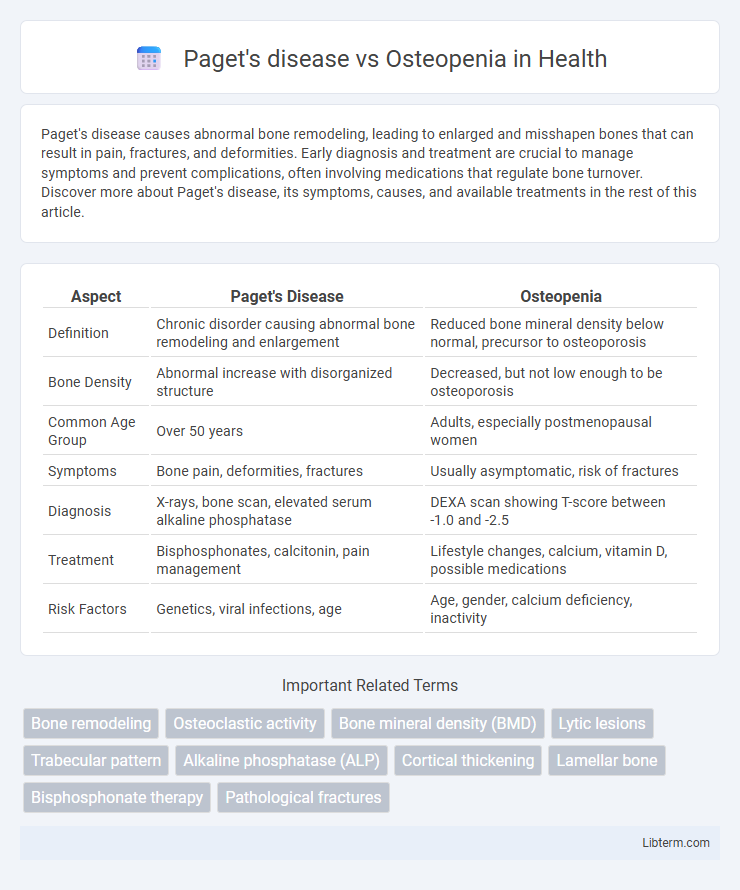Paget's disease causes abnormal bone remodeling, leading to enlarged and misshapen bones that can result in pain, fractures, and deformities. Early diagnosis and treatment are crucial to manage symptoms and prevent complications, often involving medications that regulate bone turnover. Discover more about Paget's disease, its symptoms, causes, and available treatments in the rest of this article.
Table of Comparison
| Aspect | Paget's Disease | Osteopenia |
|---|---|---|
| Definition | Chronic disorder causing abnormal bone remodeling and enlargement | Reduced bone mineral density below normal, precursor to osteoporosis |
| Bone Density | Abnormal increase with disorganized structure | Decreased, but not low enough to be osteoporosis |
| Common Age Group | Over 50 years | Adults, especially postmenopausal women |
| Symptoms | Bone pain, deformities, fractures | Usually asymptomatic, risk of fractures |
| Diagnosis | X-rays, bone scan, elevated serum alkaline phosphatase | DEXA scan showing T-score between -1.0 and -2.5 |
| Treatment | Bisphosphonates, calcitonin, pain management | Lifestyle changes, calcium, vitamin D, possible medications |
| Risk Factors | Genetics, viral infections, age | Age, gender, calcium deficiency, inactivity |
Introduction to Paget's Disease and Osteopenia
Paget's disease is a chronic bone disorder characterized by abnormal bone remodeling, leading to enlarged and misshapen bones, primarily affecting older adults. Osteopenia refers to lower-than-normal bone mineral density, representing a precursor stage to osteoporosis and increasing fracture risk. Both conditions impact bone strength but differ in pathophysiology and clinical implications, with Paget's involving excessive bone turnover and osteopenia involving decreased bone density.
Definition and Overview
Paget's disease is a chronic disorder characterized by the abnormal breakdown and formation of bone tissue, leading to enlarged and misshapen bones, commonly affecting the pelvis, skull, spine, and legs. Osteopenia is a condition defined by lower-than-normal bone mineral density, serving as a precursor to osteoporosis but without the severe bone deformities seen in Paget's disease. Both conditions impact bone strength and structure but differ significantly in their pathophysiology and clinical presentation.
Epidemiology and Prevalence
Paget's disease primarily affects older adults, with a prevalence of approximately 1-3% in individuals over 55 years, and is more common in populations of European descent. Osteopenia, characterized by reduced bone mineral density, is widespread globally, affecting nearly 38% of adults aged 50 and older, with prevalence increasing in postmenopausal women and the elderly. While Paget's disease is regionally concentrated and often asymptomatic, osteopenia represents a broader public health concern due to its potential progression to osteoporosis and associated fracture risk.
Causes and Risk Factors
Paget's disease is caused by abnormal bone remodeling due to increased osteoclastic activity often linked to genetic mutations and viral infections, primarily affecting individuals over 50 years old. Osteopenia results from decreased bone mineral density caused by factors such as aging, hormonal changes (especially decreased estrogen), inadequate calcium or vitamin D intake, and sedentary lifestyle. Risk factors for Paget's disease include family history and Northern European descent, whereas osteopenia risk factors emphasize nutritional deficiencies, physical inactivity, and chronic conditions like osteoporosis.
Pathophysiology Comparison
Paget's disease involves abnormal bone remodeling characterized by excessive osteoclastic bone resorption followed by disorganized osteoblastic bone formation, leading to structurally weak and enlarged bones. Osteopenia, in contrast, results from an imbalance favoring bone resorption over bone formation, causing reduced bone mineral density without the architectural distortion seen in Paget's disease. The pathophysiology of Paget's centers on localized accelerated bone turnover, whereas osteopenia reflects systemic bone loss often linked to aging or hormonal changes.
Clinical Manifestations
Paget's disease typically presents with bone pain, deformities, and increased bone warmth due to excessive bone remodeling, often affecting the pelvis, skull, spine, and long bones. Osteopenia is characterized by reduced bone mineral density with minimal or no symptoms but increases fracture risk, especially in the wrist, hip, and spine. Clinical manifestations of Paget's disease are more pronounced with complications like fractures, arthritis, and neurological symptoms, whereas osteopenia primarily requires diagnostic imaging for detection.
Diagnostic Criteria and Tools
Paget's disease diagnosis relies on elevated serum alkaline phosphatase levels, characteristic radiographic findings such as bone enlargement and cortical thickening, and confirmatory bone scans highlighting focal areas of increased uptake. Osteopenia is primarily diagnosed using dual-energy X-ray absorptiometry (DEXA) scans with a T-score between -1.0 and -2.5, indicating reduced bone mineral density without the structural abnormalities seen in Paget's disease. Biochemical markers and imaging modalities differentiate the localized accelerated bone remodeling in Paget's disease from the generalized bone mass reduction characteristic of osteopenia.
Treatment Approaches
Treatment for Paget's disease primarily involves bisphosphonates to regulate bone remodeling and reduce bone pain, while calcium and vitamin D supplements support bone health. Osteopenia management focuses on lifestyle modifications, including exercise and nutritional improvements, alongside bisphosphonates or other antiresorptive medications to prevent progression to osteoporosis. Regular monitoring of bone density through DEXA scans helps tailor treatment plans for both conditions.
Prognosis and Complications
Paget's disease of bone often leads to complications such as bone deformities, fractures, arthritis, and in rare cases, osteosarcoma, impacting long-term prognosis with potential progressive bone damage. Osteopenia, characterized by reduced bone mineral density, typically has a more favorable prognosis but increases the risk of developing osteoporosis and subsequent fractures if untreated. Early diagnosis and management significantly improve outcomes in both conditions by preventing severe skeletal complications and maintaining bone strength.
Key Differences and Summary
Paget's disease involves abnormal bone remodeling causing enlarged and misshapen bones, while osteopenia is characterized by reduced bone mineral density, increasing fracture risk without deformity. Paget's disease often presents with localized bone pain, deformities, and elevated alkaline phosphatase levels, whereas osteopenia is usually asymptomatic and diagnosed via DXA scans showing decreased bone density. Understanding these distinctions is critical for diagnosis, management, and treatment strategies targeting bone turnover in Paget's versus bone density preservation in osteopenia.
Paget's disease Infographic

 libterm.com
libterm.com